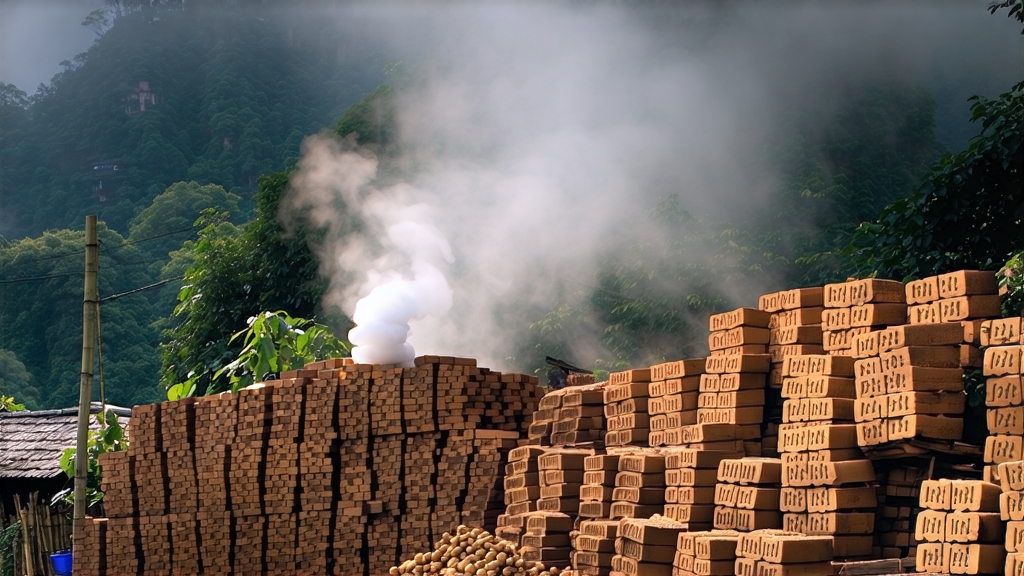
Tucked into the humid folds of southern China’s Guangxi Zhuang Autonomous Region, Liupao (literally “six fortresses”) is the least famous yet most aromatic member of the dark-tea family. While Pu-erh hogs the limelight, Liupao has spent four centuries quietly evolving in mountain caves and riverbank warehouses, emerging with a personality so distinctive that locals call it the “betel-nose tea”—a nod to the sweet, resinous top note that recalls areca nut. For international drinkers who think dark tea means only damp-earth and barnyard, Liupao offers a bridge between rustic depth and elegant uplift, a cup that smells like an old library one second and a tropical fruit basket the next.
Historical roots
The story begins during the Qing dynasty’s Kangxi reign (1662–1722), when Wuzhou city served as the gateway for trade between the Pearl River delta and the mountainous interior. Tea from the neighboring town of Cangwu had to travel south by raft along the Xun River, a journey that took weeks under monsoon skies. Merchants discovered that the humid raft decks and riverside storerooms transformed the rough green tea into something darker, smoother, and strangely perfumed. By 1702, Liupao was listed in imperial customs records as “Wu Zhou dark tea,” taxed and sealed with dragon-brand lead stamps for shipment to Hong Kong, Macau, and finally Southeast Asia, where it became a breakfast staple in Malaysian tin-mining camps. The miners believed the tea “cut the grease” of coconut rice and cured dysentery; today, elderly Malay-Chinese still greet guests with a pot of “Liu-pak” and a slice of buttered Hainanese toast.
Terroir and leaf
Liupao is not a single cultivar but a seasonal choreography of four local bushes—Da Ye Zhong (large-leaf), Ling Yun Bai Hao, Bai Mao Cha, and the rare duck-leg-shaped Ye Ya Zhong—grown between 200 and 800 m on lateritic red soils of the Yunkai mountain range. The subtropical monsoon climate delivers 1,500 mm of rain during the picking season (April to October), fattening the leaves with amino acids that later translate into cocoa sweetness. The most coveted leaves come from the “ghost slope” of Liupao village, a north-facing hillside wrapped in morning mist that refracts ultraviolet light, thickening the leaf cuticle and concentrating aromatic oils.
Crafting the darkness
Unlike Pu-erh’s sha qing (kill-green) fixation, Liupao undergoes a gentler “soft kill” at 140 °C for just three minutes, leaving a sliver of active enzymes that will drive true fermentation. The withered leaves are then rolled under low pressure to preserve cell integrity, piled 70 cm deep in bamboo trays, and sprayed with the region’s mineral-rich spring water. Enter the magic microbe: Eurotium cristatum, the same golden “flower” that blooms on Hunan’s Fu brick, but in Liupao it mingles with local strains of Aspergillus niger and Wallemia sebi. After 18 hours the pile hits 55 °C; masters turn it by hand, sniffing for the moment when the aroma flips from grassy to dried-longan sweet. A second, slower fermentation follows inside 50 kg bamboo baskets lined with wild taro leaves; the baskets are stacked in riverside caves where humidity hovers at 85 %. Over six to twelve months the tea absorbs the cave’s petrichor and taro’s green vanilla note, emerging jet-black with a golden frost of spores.
Grades and shapes
Liupao is sold in four traditional shapes, each linked to a historical transport method. The “fish-ball” (yu qiu) is a 250 g globe hand-tied with palm fiber, originally slung from rafters so river pirates could toss it ashore without damage. The “pillar” (cha zhu) is a 1 kg rod pressed into a section of bamboo trunk, favored by horse caravans. The “brick” (zhuan cha) is a 2 kg rectangle stamped with the character 茶 in seal script, still exchanged as dowry gifts in rural Guangxi. Finally, the loose “san cha” is what locals drink daily, a mix of broken leaves and golden tips that steeps fast and pairs with river-snail rice noodles.
Brewing rituals
To unlock Liupao’s betel-nose bouquet, start with 5 g of leaf in a 120 ml Yix